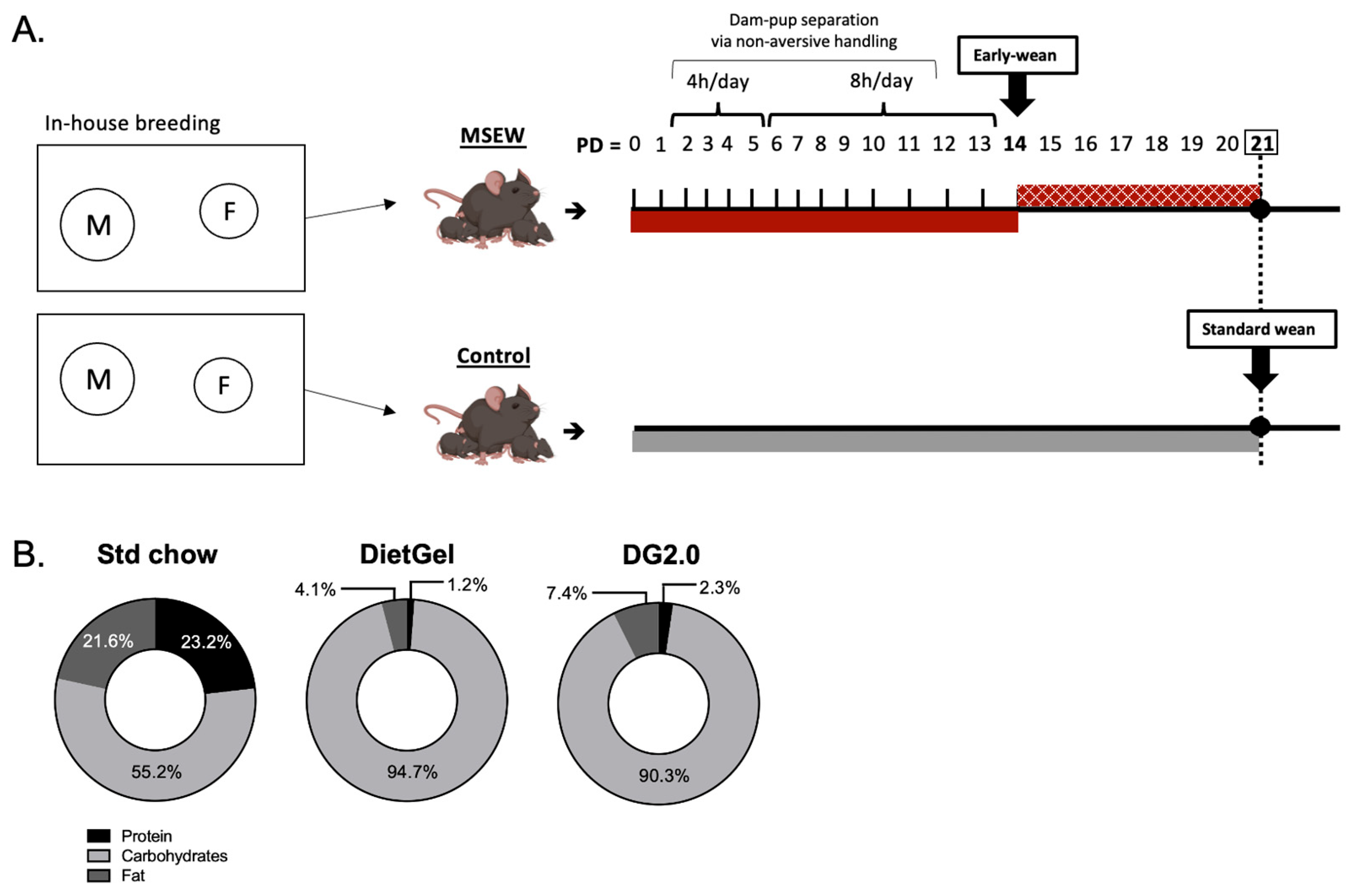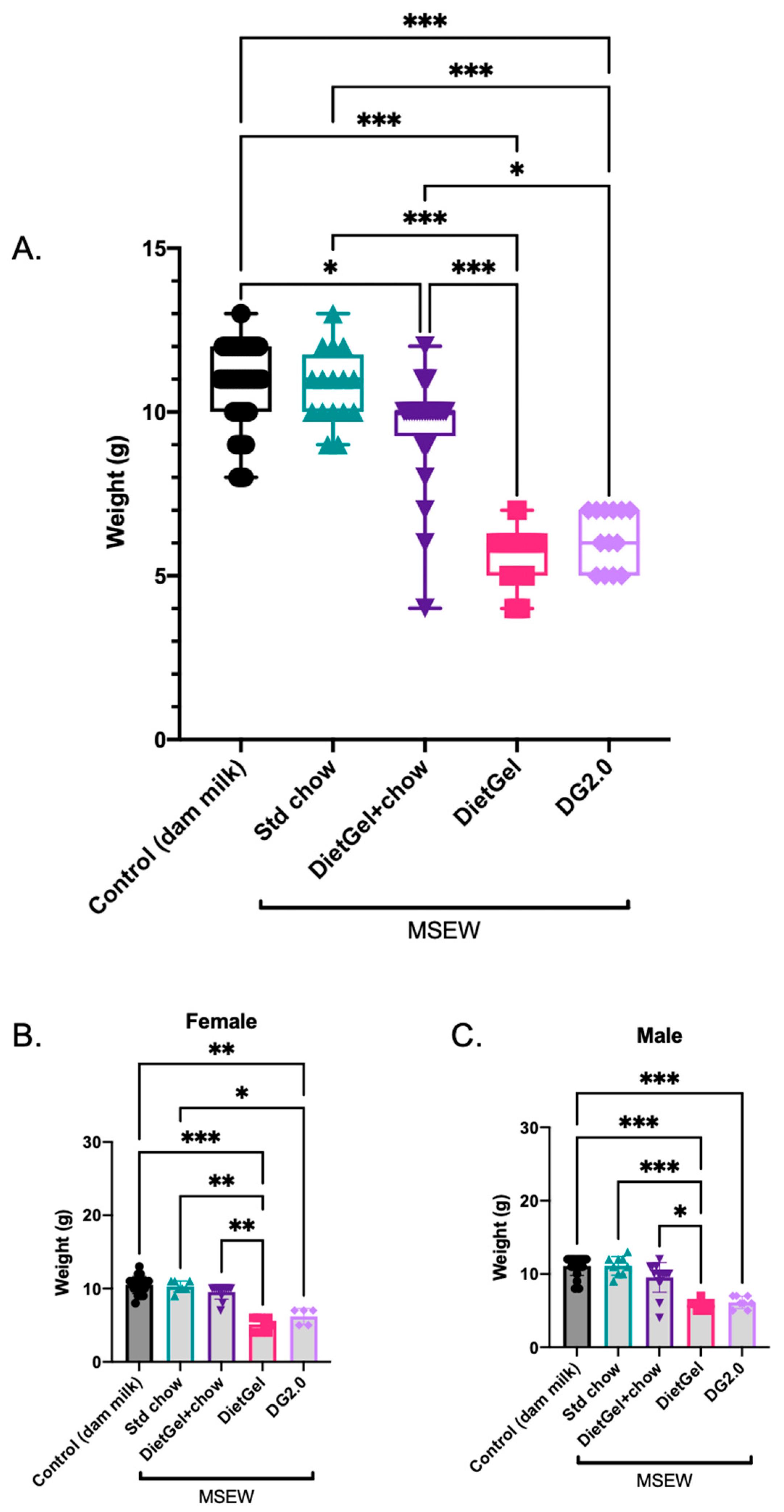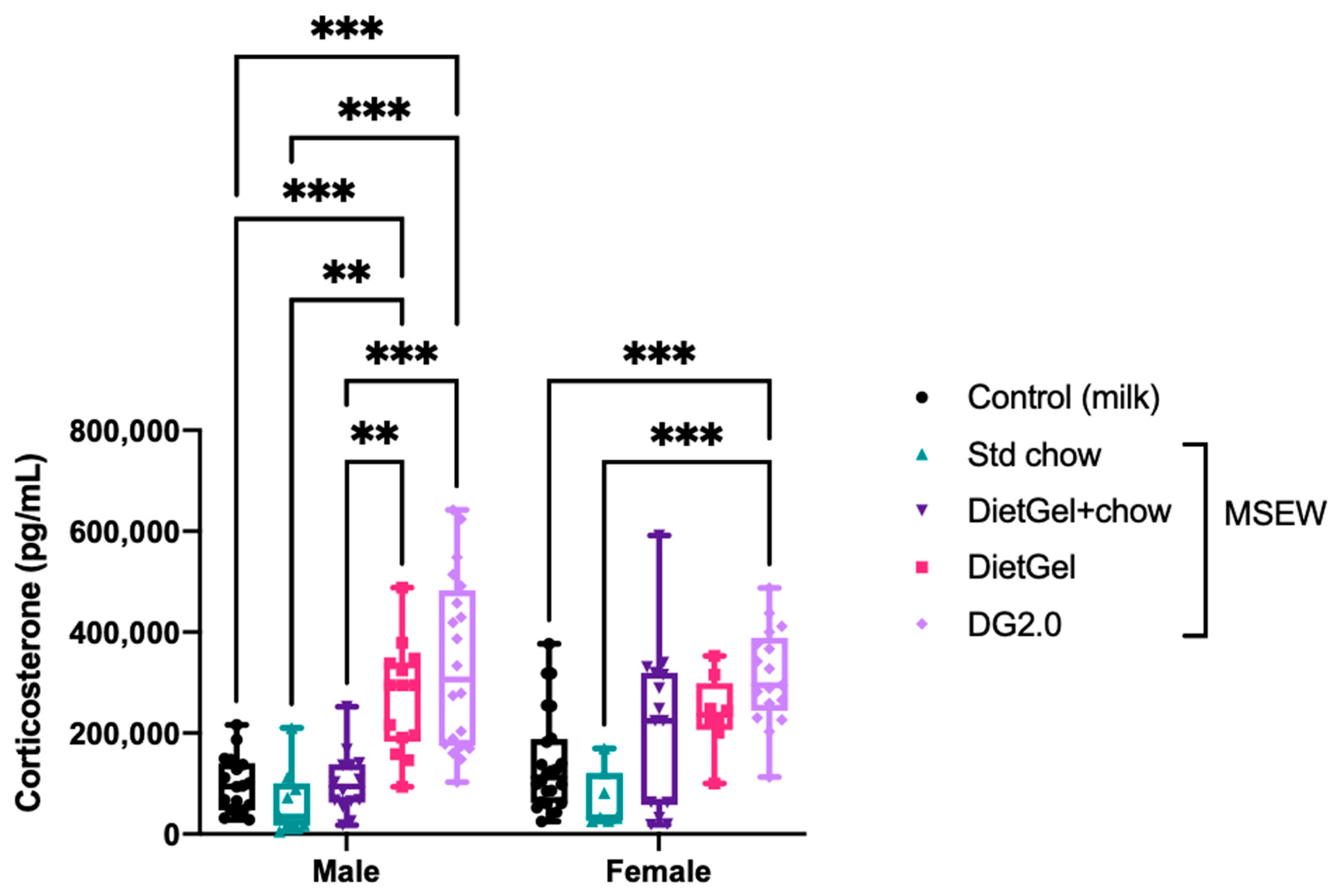Influence of Diet on Reproducible Corticosterone Levels in a Mouse Model of Maternal Separation with Early Weaning
Abstract
:1. Introduction
2. Materials and Methods
2.1. Animals
2.2. MSEW Protocol
2.3. Tissue Collection and Preparation
2.4. Corticosterone ELISA
2.5. Statistical Analyses
3. Results
3.1. Variation in the Non-Milk Diet Alone Impacts Body Weight
3.2. Select Non-Milk Diets Increased Circulating Corticosterone
4. Discussion
5. Conclusions
Supplementary Materials
Author Contributions
Funding
Institutional Review Board Statement
Informed Consent Statement
Data Availability Statement
Acknowledgments
Conflicts of Interest
References
- Gilbert, R.; Widom, C.S.; Browne, K.; Fergusson, D.; Webb, E.; Janson, S. Burden and consequences of child maltreatment in high-income countries. Lancet 2009, 373, 68–81. [Google Scholar] [CrossRef] [PubMed]
- Anda, R.F.; Felitti, V.J.; Bremner, J.D.; Walker, J.D.; Whitfield, C.; Perry, B.D.; Dube, S.R.; Giles, W.H. The enduring effects of abuse and related adverse experiences in childhood. A convergence of evidence from neurobiology and epidemiology. Eur. Arch. Psychiatry Clin. Neurosci. 2006, 256, 174–186. [Google Scholar] [CrossRef] [PubMed]
- Felitti, V.J.; Anda, R.F.; Nordenberg, D.; Williamson, D.F.; Spitz, A.M.; Edwards, V.; Koss, M.P.; Marks, J.S. Relationship of childhood abuse and household dysfunction to many of the leading causes of death in adults. The Adverse Childhood Experiences (ACE) Study. Am. J. Prev. Med. 1998, 14, 245–258. [Google Scholar] [CrossRef] [PubMed]
- Lee, V.M.; Hargrave, A.S.; Lisha, N.E.; Huang, A.J. Adverse Childhood Experiences and Aging-Associated Functional Impairment in a National Sample of Older Community-Dwelling Adults. J. Gen. Intern. Med. 2023, 38, 3362–3371. [Google Scholar] [CrossRef] [PubMed]
- Danese, A.; Pariante, C.M.; Caspi, A.; Taylor, A.; Poulton, R. Childhood maltreatment predicts adult inflammation in a life-course study. Proc. Natl. Acad. Sci. USA 2007, 104, 1319–1324. [Google Scholar] [CrossRef] [PubMed]
- Wegman, H.L.; Stetler, C. A meta-analytic review of the effects of childhood abuse on medical outcomes in adulthood. Psychosom. Med. 2009, 71, 805–812. [Google Scholar] [CrossRef] [PubMed]
- Korkeila, J.; Vahtera, J.; Korkeila, K.; Kivimäki, M.; Sumanen, M.; Koskenvuo, K.; Koskenvuo, M. Childhood adversities as predictors of incident coronary heart disease and cerebrovascular disease. Heart 2010, 96, 298–303. [Google Scholar] [CrossRef] [PubMed]
- Thurston, R.C.; Chang, Y.; Derby, C.A.; Bromberger, J.T.; Harlow, S.D.; Janssen, I.; Matthews, K.A. Abuse and subclinical cardiovascular disease among midlife women: The study of women’s health across the nation. Stroke 2014, 45, 2246–2251. [Google Scholar] [CrossRef]
- Carson, M.Y.; Barinas-Mitchell, E.; Maki, P.M.; Thurston, R.C. Childhood Maltreatment and Arterial Stiffness Among Midlife Women. J. Am. Heart Assoc. 2022, 11, e026081. [Google Scholar] [CrossRef]
- Lee, J.K.; Lee, J.; Chung, M.K.; Park, J.Y.; Shin, T.; Lee, K.J.; Lim, H.S.; Hwang, S.; Urtnasan, E.; Jo, Y.; et al. Childhood adversity and late-life depression: Moderated mediation model of stress and social support. Front. Psychiatry 2023, 14, 1183884. [Google Scholar] [CrossRef]
- Fink, D.S.; Galea, S. Life course epidemiology of trauma and related psychopathology in civilian populations. Curr. Psychiatry Rep. 2015, 17, 31. [Google Scholar] [CrossRef] [PubMed]
- Brew, B.K.; Lundholm, C.; Caffrey Osvald, E.; Chambers, G.; Öberg, S.; Fang, F.; Almqvist, C. Early-Life Adversity Due to Bereavement and Inflammatory Diseases in the Next Generation: A Population Study in Transgenerational Stress Exposure. Am. J. Epidemiol. 2021, 191, 38–48. [Google Scholar] [CrossRef] [PubMed]
- Lee, J.-H.; Kim, H.J.; Kim, J.G.; Ryu, V.; Kim, B.-T.; Kang, D.-W.; Jahng, J.W. Depressive behaviors and decreased expression of serotonin reuptake transporter in rats that experienced neonatal maternal separation. Neurosci. Res. 2007, 58, 32–39. [Google Scholar] [CrossRef] [PubMed]
- Targum, S.D.; Nemeroff, C.B. The Effect of Early Life Stress on Adult Psychiatric Disorders. Innov. Clin. Neurosci. 2019, 16, 35–37. [Google Scholar] [PubMed]
- Danese, A.; Moffitt, T.E.; Pariante, C.M.; Ambler, A.; Poulton, R.; Caspi, A. Elevated inflammation levels in depressed adults with a history of childhood maltreatment. Arch. Gen. Psychiatry 2008, 65, 409–415. [Google Scholar] [CrossRef] [PubMed]
- Danese, A.; Moffitt, T.E.; Harrington, H.; Milne, B.J.; Polanczyk, G.; Pariante, C.M.; Poulton, R.; Caspi, A. Adverse childhood experiences and adult risk factors for age-related disease: Depression, inflammation, and clustering of metabolic risk markers. Arch. Pediatr. Adolesc. Med. 2009, 163, 1135–1143. [Google Scholar] [CrossRef] [PubMed]
- Lesuis, S.L.; Lucassen, P.J.; Krugers, H.J. Early life stress amplifies fear responses and hippocampal synaptic potentiation in the APPswe/PS1dE9 Alzheimer mouse model. Neuroscience 2021, 454, 151–161. [Google Scholar] [CrossRef] [PubMed]
- Tschetter, K.E.; Callahan, L.B.; Flynn, S.A.; Rahman, S.; Beresford, T.P.; Ronan, P.J. Early life stress and susceptibility to addiction in adolescence. Int. Rev. Neurobiol. 2022, 161, 277–302. [Google Scholar] [CrossRef] [PubMed]
- Pettway, Y.D.; Neder, T.H.; Ho, D.H.; Fox, B.M.; Burch, M.; Colson, J.; Liu, X.; Kellum, C.E.; Hyndman, K.A.; Pollock, J.S. Early life stress induces dysregulation of the heme pathway in adult mice. Physiol. Rep. 2021, 9, e14844. [Google Scholar] [CrossRef]
- Rincón-Cortés, M. Sex differences in addiction-relevant behavioral outcomes in rodents following early life stress. Addict. Neurosci. 2023, 6, 100067. [Google Scholar] [CrossRef]
- Calanni, J.S.; Dieguez, H.H.; González Fleitas, M.F.; Canepa, E.; Berardino, B.; Repetto, E.M.; Villarreal, A.; Dorfman, D.; Rosenstein, R.E. Early life stress induces visual dysfunction and retinal structural alterations in adult mice. J. Neurochem. 2023, 165, 362–378. [Google Scholar] [CrossRef] [PubMed]
- Muir, R.Q.; Klocke, B.J.; Jennings, M.S.; Molina, P.A.; Hsu, J.S.; Kellum, C.E.; Alexander, K.L.; Lee, G.; Foote, J.B.; Lorenz, R.G.; et al. Early Life Stress in Mice Leads to Impaired Colonic Corticosterone Production and Prolonged Inflammation Following Induction of Colitis. Inflamm. Bowel Dis. 2023, 29, 960–972. [Google Scholar] [CrossRef] [PubMed]
- Leyrer-Jackson, J.M.; Overby, P.F.; Nagy, E.K.; Olive, M.F. Early Life Stress Promotes Heroin Seeking But Does Not Alter the Excitability of Insular Pyramidal Cells Targeting the Nucleus Accumbens. Front. Behav. Neurosci. 2021, 15, 777826. [Google Scholar] [CrossRef] [PubMed]
- Apaydin, D.C.; Jaramillo, P.A.M.; Corradi, L.; Cosco, F.; Rathjen, F.G.; Kammertoens, T.; Filosa, A.; Sawamiphak, S. Early-Life Stress Regulates Cardiac Development through an IL-4-Glucocorticoid Signaling Balance. Cell Rep. 2020, 33, 108404. [Google Scholar] [CrossRef] [PubMed]
- Fu, Q.; Frick, J.M.; O’Neil, M.F.; Eller, O.C.; Morris, E.M.; Thyfault, J.P.; Christianson, J.A.; Lane, R.H. Early-life stress perturbs the epigenetics of Cd36 concurrent with adult onset of NAFLD in mice. Pediatr. Res. 2023, 94, 1942–1950. [Google Scholar] [CrossRef] [PubMed]
- Brix, L.M.; Monleon, D.; Collado, M.C.; Ederveen, T.H.A.; Toksöz, I.; Bordes, J.; van Doeselaar, L.; Engelhardt, C.; Mitra, S.; Narayan, S.; et al. Metabolic effects of early life stress and pre-pregnancy obesity are long lasting and sex specific in mice. Eur. J. Neurosci. 2023, 58, 2215–2231. [Google Scholar] [CrossRef] [PubMed]
- Waterston, R.H.; Lindblad-Toh, K.; Birney, E.; Rogers, J.; Abril, J.F.; Agarwal, P.; Agarwala, R.; Ainscough, R.; Alexandersson, M.; An, P.; et al. Initial sequencing and comparative analysis of the mouse genome. Nature 2002, 420, 520–562. [Google Scholar] [CrossRef]
- Demaestri, C.; Pan, T.; Critz, M.; Ofray, D.; Gallo, M.; Bath, K.G. Type of early life adversity confers differential, sex-dependent effects on early maturational milestones in mice. Horm. Behav. 2020, 124, 104763. [Google Scholar] [CrossRef]
- George, E.D.; Bordner, K.A.; Elwafi, H.M.; Simen, A.A. Maternal separation with early weaning: A novel mouse model of early life neglect. BMC Neurosci. 2010, 11, 123. [Google Scholar] [CrossRef]
- Murthy, S.; Gould, E. Early life stress in rodents: Animal models of illness or resilience? Front. Behav. Neurosci. 2018, 12, 157. [Google Scholar] [CrossRef]
- Parfitt, D.B.; Walton, J.R.; Corriveau, E.A.; Helmreich, D.L. Early life stress effects on adult stress-induced corticosterone secretion and anxiety-like behavior in the C57BL/6 mouse are not as robust as initially thought. Horm. Behav. 2007, 52, 417–426. [Google Scholar] [CrossRef] [PubMed]
- Carlyle, B.C.; Duque, A.; Kitchen, R.R.; Bordner, K.A.; Coman, D.; Doolittle, E.; Papademetris, X.; Hyder, F.; Taylor, J.R.; Simen, A.A. Maternal separation with early weaning: A rodent model providing novel insights into neglect associated developmental deficits. Dev. Psychopathol. 2012, 24, 1401–1416. [Google Scholar] [CrossRef] [PubMed]
- Kikusui, T.; Ichikawa, S.; Mori, Y. Maternal deprivation by early weaning increases corticosterone and decreases hippocampal BDNF and neurogenesis in mice. Psychoneuroendocrinology 2009, 34, 762–772. [Google Scholar] [CrossRef] [PubMed]
- Wang, D.; Levine, J.L.S.; Avila-Quintero, V.; Bloch, M.; Kaffman, A. Systematic review and meta-analysis: Effects of maternal separation on anxiety-like behavior in rodents. Transl. Psychiatry 2020, 10, 174. [Google Scholar] [CrossRef] [PubMed]
- Rocha, M.; Wang, D.; Avila-Quintero, V.; Bloch, M.H.; Kaffman, A. Deficits in hippocampal-dependent memory across different rodent models of early life stress: Systematic review and meta-analysis. Transl. Psychiatry 2021, 11, 231. [Google Scholar] [CrossRef] [PubMed]
- Tan, S.; Ho, H.S.; Song, A.Y.; Low, J.; Je, H.S. Maternal Separation Does Not Produce a Significant Behavioral Change in Mice. Exp. Neurobiol. 2017, 26, 390–398. [Google Scholar] [CrossRef] [PubMed]
- Stupart, O.; Robbins, T.W.; Dalley, J.W. “The wrong tools for the right job”: A critical meta-analysis of traditional tests to assess behavioural impacts of maternal separation. Psychopharmacology 2023, 240, 2239–2256. [Google Scholar] [CrossRef] [PubMed]
- Wolterink-Donselaar, I.G.; Meerding, J.M.; Fernandes, C. A method for gender determination in newborn dark pigmented mice. Lab. Anim. 2009, 38, 35–38. [Google Scholar] [CrossRef] [PubMed]
- Gouveia, K.; Hurst, J.L. Optimising reliability of mouse performance in behavioural testing: The major role of non-aversive handling. Sci. Rep. 2017, 7, 44999. [Google Scholar] [CrossRef]
- Gouveia, K.; Hurst, J.L. Reducing mouse anxiety during handling: Effect of experience with handling tunnels. PLoS ONE 2013, 8, e66401. [Google Scholar] [CrossRef]
- Sensini, F.; Inta, D.; Palme, R.; Brandwein, C.; Pfeiffer, N.; Riva, M.A.; Gass, P.; Mallien, A.S. The impact of handling technique and handling frequency on laboratory mouse welfare is sex-specific. Sci. Rep. 2020, 10, 17281. [Google Scholar] [CrossRef] [PubMed]
- Clarkson, J.M.; Dwyer, D.M.; Flecknell, P.A.; Leach, M.C.; Rowe, C. Handling method alters the hedonic value of reward in laboratory mice. Sci. Rep. 2018, 8, 2448. [Google Scholar] [CrossRef]
- Hurst, J.L.; West, R.S. Taming anxiety in laboratory mice. Nat. Methods 2010, 7, 825–826. [Google Scholar] [CrossRef] [PubMed]
- Ulrich-Lai, Y.M.; Figueiredo, H.F.; Ostrander, M.M.; Choi, D.C.; Engeland, W.C.; Herman, J.P. Chronic stress induces adrenal hyperplasia and hypertrophy in a subregion-specific manner. Am. J. Physiol. Endocrinol. Metab. 2006, 291, E965–E973. [Google Scholar] [CrossRef] [PubMed]
- Delpierre, C.; Fantin, R.; Barboza-Solis, C.; Lepage, B.; Darnaudéry, M.; Kelly-Irving, M. The early life nutritional environment and early life stress as potential pathways towards the metabolic syndrome in mid-life? A lifecourse analysis using the 1958 British Birth cohort. BMC Public Health 2016, 16, 815. [Google Scholar] [CrossRef]
- Juncker, H.G.; van Keulen, B.J.; Finken, M.J.J.; de Rooij, S.R.; van Goudoever, J.B.; Korosi, A. The Potential Role of Nutrition in Modulating the Long-Term Consequences of Early-Life Stress. Nestlé Nutr. Inst. Workshop Ser. 2021, 96, 116–129. [Google Scholar] [CrossRef]




| Kruskal-Wallis Test (Multiple Comparisons) | |
|---|---|
| (A) Combined sexes | |
| p value | <0.001 |
| Exact or approximate p value? | Approximate |
| p value summary | *** |
| Do the medians vary signif. (p < 0.05) | Yes |
| Number of groups | 5 |
| Kruskal-Wallis statistic | 82.58 |
| (B) Females | |
| p value | <0.001 |
| Exact or approximate p value? | Approximate |
| p value summary | *** |
| Do the medians vary signif. (p < 0.05) | Yes |
| Number of groups | 5 |
| Kruskal-Wallis statistic | 35.38 |
| (C) Males | |
| p value | <0.001 |
| Exact or approximate p value? | Approximate |
| p value summary | *** |
| Do the medians vary signif. (p < 0.05) | Yes |
| Number of groups | 5 |
| Kruskal-Wallis statistic | 46.98 |
| ANOVA Table | F (DFn, DFd) | p Value |
|---|---|---|
| Interaction | F (4, 136) = 1.874 | p = 0.12 |
| Sex | F (1, 136) = 1.095 | p = 0.30 |
| Treatment | F (4, 136) = 25.38 | p < 0.001 |
Disclaimer/Publisher’s Note: The statements, opinions and data contained in all publications are solely those of the individual author(s) and contributor(s) and not of MDPI and/or the editor(s). MDPI and/or the editor(s) disclaim responsibility for any injury to people or property resulting from any ideas, methods, instructions or products referred to in the content. |
© 2024 by the authors. Licensee MDPI, Basel, Switzerland. This article is an open access article distributed under the terms and conditions of the Creative Commons Attribution (CC BY) license (https://creativecommons.org/licenses/by/4.0/).
Share and Cite
Choe, J.Y.; Donkor, M.; Thorpe, R.J., Jr.; Allen, M.S.; Phillips, N.R.; Jones, H.P. Influence of Diet on Reproducible Corticosterone Levels in a Mouse Model of Maternal Separation with Early Weaning. Life 2024, 14, 880. https://doi.org/10.3390/life14070880
Choe JY, Donkor M, Thorpe RJ Jr., Allen MS, Phillips NR, Jones HP. Influence of Diet on Reproducible Corticosterone Levels in a Mouse Model of Maternal Separation with Early Weaning. Life. 2024; 14(7):880. https://doi.org/10.3390/life14070880
Chicago/Turabian StyleChoe, Jamie Y., Michael Donkor, Roland J. Thorpe, Jr., Michael S. Allen, Nicole R. Phillips, and Harlan P. Jones. 2024. "Influence of Diet on Reproducible Corticosterone Levels in a Mouse Model of Maternal Separation with Early Weaning" Life 14, no. 7: 880. https://doi.org/10.3390/life14070880
APA StyleChoe, J. Y., Donkor, M., Thorpe, R. J., Jr., Allen, M. S., Phillips, N. R., & Jones, H. P. (2024). Influence of Diet on Reproducible Corticosterone Levels in a Mouse Model of Maternal Separation with Early Weaning. Life, 14(7), 880. https://doi.org/10.3390/life14070880







